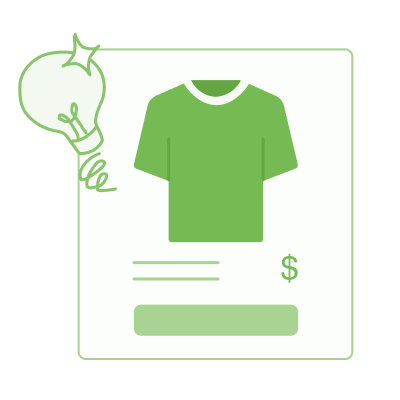Start SellingOnline Now!
Summarize the blog with Artificial Intelligence (AI):
Venturing into the e-commerce sector can feel like navigating a labyrinth, especially for newcomers. The industry is brimming with jargon, and emerging technologies, making it crucial to stay informed and adaptable.
To streamline your journey, we’ve curated a comprehensive guide featuring 19 indispensable e-commerce tips tailored for small businesses. You can use these tips to empower your new e-commerce store, or you can implement them in your already existing business to increase your online sales.

Highlights
- Build relationships with influencers early on to create brand advocates.
- Try to think like a customer to understand what you can improve.
- Be agile and experiment. Small changes that you can try with A/B testing can have impressive results.
- Social media presence is vital if you want your business to be successful.
- Engage and connect with your customers, make them feel like a community.
- Upselling and cross-selling are time-tested sales techniques. Use them wisely.
- Reclaim your leads with retargeting ads.
- Prepare an FAQ page to reduce the burden on your customer service.
- Create free marketing with customized packages.
Related Article: Community Management For Small Businesses

19 E-Commerce Tips For Small Businesses
1. Build Relationships With Influencers
Influencer marketing is a very profitable venture to invest in. According to The State Of Influencer Marketing 2020, the average expected return for influencer marketing is $5.78 for every single dollar spent. When you consider that Pay-Per-Click (PPC) campaigns only return 2$ for every 1$ spent, we can conclude that influencer marketing is still a very profitable marketing channel.
To truly reap all the benefits of this marketing channel, you should consider establishing relationships with relevant influencers in your industry.
Spending some time to create lasting relationships with influencers can be one of the best e-commerce tips you can implement.
When building relationships with influencers, do not forget that they are people too! They will appreciate respectful and friendly communication.
Also, they will be well-versed and interested in your industry.
Related Article: What is Affiliate Marketing?
2. Think Like A Customer
You are the owner of your business. But from the perspective of other businesses, you are still a customer. Think about it, the local deli you regularly visit sees you as their customer, and so does your dentist and hairdresser. Basically, you already know how to think like a customer!

Criticize your business from the perspective of a customer. Does your website look trustworthy? Would you enjoy your customer service if you were in need of help? Would you use your products the way you expect your customers to do?
Answer these questions, and adjust your practices accordingly.
3. Experiment
E-commerce businesses are more flexible than brick-and-mortar stores. You can switch to a new- generation e-commerce platform, try out different online marketplaces, or change your entire website design!
So do not hesitate to try something different!
Try out different designs, marketing strategies, sales channels. You can even experiment on how to categorize your products. Try to find what your audience loves. Experimenting can be stressful, but finding the right combination is worth it.
4. Focus On Social Media
Yeah, you have probably heard this one before, but it is still very important to emphasize! This is definitely one of the e-commerce tips you should be implementing.

Having well-maintained social media accounts makes your business more presentable.
Customers research products and businesses on different channels. So a customer who has found you through a Google search might want to check your Instagram to get more information about your business.
Finding an empty page might be discouraging for them while finding a vibrant page full of customer testimonials and engaging content might drive them to make a purchase.
Social media presence also goes a long way in marketing. Social media marketing is a cheap way to create organic traffic for your business. If you can create engaging content with a robust social media strategy, your potential customers will find you.
Related Article: What is Social Media Marketing?
5. Connect With Your Customers
Customers no longer only want a product, they also want the experience a brand can provide. A part of that experience is the connection between the brand and the customer.
If you are only going to implement one of our e-commerce tips, then this should be the one to consider.
You can create a robust connection with your customers by implementing the following techniques:
- Inform your customers about product updates and company news with a newsletter.
- Check-in with your customers after their purchases.
- Engage with your customers via social media and direct messages.

6. Leverage Up-sell And Cross-sell
Leveraging the power of upselling and cross-selling is a strategic move that can transform the financial landscape of your business. These proven sales methodologies extend beyond mere transactional benefits; they significantly amplify your profits, deepen customer loyalty toward your brand, and play a pivotal role in minimizing customer churn rates.
Upselling encourages customers to consider a higher-end, more expensive version of the chosen item, offering them enhanced value and satisfaction. It’s an art that, when executed with finesse, does not merely push for a pricier purchase but enlightens customers about the benefits and added value they receive by opting for a superior product. This strategy not only increases the average order value but also elevates the customer’s perception of your brand as a curator of quality and excellence.
Cross-selling, on the other hand, is the practice of suggesting complementary products or services that augment the customer’s initial choice, creating a more satisfying and comprehensive shopping experience. By carefully analyzing purchase history and customer preferences, you can present personalized recommendations that feel thoughtful and tailored, thereby enhancing the customer journey. This approach not only boosts sales but also strengthens the customer’s connection with your brand, as they perceive your business as understanding and catering to their holistic needs.
When implemented effectively, both upselling and cross-selling weave into the fabric of a customer-centric shopping experience. These strategies should be nurtured by deep insights into customer behavior, preferences, and the value proposition of your offerings. The key lies in striking the perfect balance between maximizing revenue opportunities and enriching the customer experience.
7. Use Retargeting Ads
Here is an e-commerce tip for digital marketers:
Retargeting ads reach the customers who have interacted with your business before. You can see them as little reminders to shoppers who have considered purchasing from you but didn’t go through with it for some reason.
Around 92% of customers are not ready to make a purchase when they first visit your website. So it is in your best interest to remind them that you exist from time to time.
Retargeting ads are great for this purpose. You can retarget people who have previously interacted with your ads, visited your website, or abandoned their carts. Seeing your ad a second time might be enough to make them complete their purchase.
8. Prepare an FAQs Page
If you are looking for e-commerce tips related to your website content, then this is one of the entries you should definitely read!
Customers will have questions about your business, and creating an FAQs page to preemptively answer them could increase your chances of making a sale. It will also reduce the burden on your customer service team.
When preparing an FAQs page try to focus on the immediate questions your customers might ask. The best feedback you can get for your FAQs page is again, your customers!
Compile a list of questions you receive, and add the most often-asked questions to your FAQs page.
Related Article: Business Ideas

9. Customize Your Packaging
Producing customized packaging can be a great opportunity to create marketing opportunities! Especially if your packages are reusable in some way!
Your customers can use those packages to carry something else outside or use them as a box in their homes. Having your logo on display will probably draw some eyes.
Customized packaging can also increase customer loyalty. Shoppers always appreciate a cute box or a well-designed package.
Related Article: What is Product Bundling?

10. Optimize for Mobile
Optimizing your e-commerce site for mobile is essential as the majority of internet users access the web through mobile devices. A responsive website design is crucial, automatically adjusting the layout and content to fit the device’s screen size. This ensures accessibility and navigability across smartphones, tablets, and desktops. Mobile users expect quick loading times, so it’s important to optimize images, minify code, and leverage browser caching to improve site speed. Google’s PageSpeed Insights can help identify areas for improvement.
Simplified navigation tailored for limited screen space can enhance the user experience, employing a hamburger menu to save space and keep the site uncluttered. Making all interactive elements touch-friendly is also vital; buttons, links, and form fields should be easily clickable with a finger. The checkout process should be streamlined to reduce cart abandonment rates, minimizing the number of steps and fields required to complete a purchase. Offering guest checkout options and using autofill can speed up this process.
Using large, readable fonts ensures text is easy to read on small screens, and optimizing images and videos for quick loading without compromising quality is key. Testing your site on multiple devices helps identify and fix issues impacting mobile users. A mobile-first design approach prioritizes the needs of mobile users from the start, potentially improving the overall user experience.
Leveraging Accelerated Mobile Pages (AMP) can also improve mobile site performance, speeding up page loading times and possibly increasing visibility in search results. By focusing on these aspects, you can create a mobile-optimized e-commerce site that not only meets user expectations but also supports business goals by enhancing engagement, reducing bounce rates, and boosting conversions.
11. Use High-Quality Product Images and Descriptions
High-quality product images and detailed descriptions are fundamental to the success of an e-commerce store. They play a critical role in the customer’s decision-making process, as online shoppers rely heavily on visuals and product information to make purchasing decisions. Since customers can’t physically touch or see the products in person, your online presentation must bridge this sensory gap effectively.
For product images, it’s essential to use high-resolution photos that accurately represent the product. Providing multiple angles and zoom-in features allows customers to examine the product in detail, similar to how they might inspect it in a physical store. Including images of the product in use or in context can also help customers better understand its size, scale, and functionality. This visual clarity can significantly reduce the likelihood of returns and increase customer satisfaction.
When it comes to product descriptions, clarity, and completeness are key. Each description should provide all the necessary information about the product, including its features, benefits, dimensions, materials, and any other relevant details. However, it’s not just about listing specifications; it’s also about telling a compelling story that connects with your customers on an emotional level. Highlighting how the product can solve a problem or improve the customer’s life can make the description more persuasive.
Providing care instructions, usage tips, and any additional information that adds value to the customer can further enhance the product page. This not only helps in building trust but also positions your brand as a knowledgeable and customer-centric retailer.
Incorporating customer reviews and ratings alongside product descriptions can also bolster the credibility of your products. Reviews serve as social proof, helping potential buyers feel more confident in their purchasing decisions.
12. Implement SEO Best Practices
Implementing SEO best practices is crucial for enhancing the visibility of your e-commerce store in search engine results, driving more traffic, and increasing sales. Understanding your audience and the keywords they use when searching for your products is the foundation of a good SEO strategy. Tools like Google Keyword Planner and SEMrush can help identify relevant keywords to incorporate into your product titles, descriptions, meta tags, and URLs, making your pages more attractive to search engines.
An organized website structure improves both user experience and search engine indexing. A clear hierarchy with well-defined categories and subcategories ensures that both users and search engines can navigate your site effectively. Page loading speed is also a critical factor; optimizing images, minimizing code, and leveraging browser caching can enhance your site’s performance. Google’s PageSpeed Insights offers tailored recommendations for speeding up your website.
With the dominance of mobile searches, having a mobile-friendly website is non-negotiable. Responsive design ensures your site adjusts to any screen size, improving user experience and supporting SEO efforts. Content quality cannot be overstated; engaging, valuable content attracts traffic, encourages backlinks, and increases visitor engagement, which are all positive signals to search engines.
Title tags and meta descriptions significantly influence click-through rates from search engine results pages. Crafting unique, keyword-rich titles and descriptions for each page can draw in potential visitors. Implementing schema markup enhances your SERP appearance by providing users with detailed information about your products, such as pricing and availability, directly in search results.
Building quality backlinks from reputable sites boosts your site’s authority and search engine ranking. Creating shareable content and engaging with your community are effective strategies for acquiring backlinks. Monitoring your SEO performance through tools like Google Analytics and Google Search Console helps you understand traffic patterns and identify optimization opportunities.
SEO is an ever-evolving field, with search engine algorithms constantly updating. Staying informed about the latest trends and best practices is essential for maintaining and improving your site’s visibility in search results. By adopting these SEO strategies, you can increase your e-commerce store’s search engine ranking, attract more targeted traffic, and ultimately boost your sales and revenue.
13. Offer Excellent Customer Support
Offering excellent customer support is pivotal in building trust, fostering loyalty, and encouraging repeat business in the e-commerce industry. In a digital marketplace where personal interaction is limited, the quality of your customer support can significantly differentiate your brand and influence purchasing decisions.
To achieve excellence in customer support, start by ensuring multiple channels of communication are available to your customers. This includes traditional methods like phone and email, as well as modern avenues such as live chat, social media, and messaging apps. Providing a variety of channels caters to different customer preferences and ensures that support is readily accessible.
Responsiveness is key to effective customer support. Customers expect quick replies to their inquiries and resolutions to their issues. Setting up automated responses for common questions can provide immediate assistance, while a dedicated team should handle more complex queries promptly. This balance ensures that customers are not left waiting, enhancing their overall satisfaction with your service.
Personalization adds significant value to customer interactions. Addressing customers by name, understanding their history with your brand, and tailoring solutions to their specific needs can make the support experience feel more personal and caring. Utilizing customer relationship management (CRM) tools can help gather and analyze customer data, enabling more personalized and efficient service.
Training your support team is crucial. A well-informed team that understands your products, policies, and procedures can provide accurate and helpful information to customers. Regular training sessions can keep the team updated on new products, promotions, and policies, ensuring that they are well equipped to assist customers effectively.
Soliciting feedback from customers about their support experience can provide valuable insights into areas for improvement. This can be done through post-interaction surveys or feedback forms. Actively listening to customer feedback and making necessary adjustments demonstrates a commitment to excellence and continuous improvement in customer service.
Proactively engaging with customers can also enhance support. This involves reaching out to customers to inform them about product updates, company news, or simply checking in after a purchase to ensure satisfaction. Such proactive communication can prevent issues before they arise and strengthen the customer-brand relationship.
Excellence in customer support is not just about resolving issues but creating positive, memorable experiences that encourage customers to return. By implementing these strategies, e-commerce businesses can build a strong rapport with their customers, leading to increased loyalty, satisfaction, and ultimately, business success.
14. Implement a Loyalty Program
Implementing a loyalty program can significantly enhance customer retention and increase the lifetime value of your customers in the e-commerce sector. A well-designed loyalty program rewards customers for their repeated business, encouraging them to continue shopping with you instead of turning to competitors.
To embark on the creation of a loyalty program for your business, it’s essential to start with a clear understanding of your objectives. Determining what you wish to achieve, whether it’s elevating the average order value, increasing purchase frequency, or enhancing customer loyalty, sets a clear direction for your program’s design and implementation.
Gaining a deep understanding of your customers is crucial. By analyzing their purchasing behaviors, preferences, and values, you can tailor a loyalty program that resonates with them on a personal level. This ensures the rewards and benefits you offer are not only attractive but also meaningful, enhancing their overall engagement with your brand.
Selecting the right reward structure is also a pivotal step. The landscape of loyalty programs offers a variety of formats, from points-based systems, which reward customers with redeemable points for each purchase, to tiered and VIP programs that incentivize higher spending with greater rewards. The key is to choose a structure that aligns with your business goals and appeals to your customer base.
The success of your loyalty program also hinges on its accessibility and ease of use. A program that’s complicated to understand or join can deter potential participants. Strive for simplicity in how rewards are earned and redeemed, and ensure this process is communicated clearly to your customers.
Promotion plays a significant role in the effectiveness of your loyalty program. Utilizing various channels such as your website, email, and social media ensures your existing and potential customers are aware of the program and the benefits it offers. Highlighting the value and rewards can significantly increase participation rates.
Personalization can elevate your loyalty program from good to great. By customizing rewards and communications based on individual customer data, you make your program more engaging and relevant, thereby increasing its impact on customer loyalty.
To continually enhance your loyalty program, it’s vital to collect and analyze data on its performance. This includes tracking participation, redemption rates, and its overall effect on customer behavior. Such insights are invaluable for refining and improving your program over time.
Ensure that your loyalty program is not an isolated element but an integrated part of your overall customer experience. This integration across your e-commerce platform, customer service, and marketing initiatives creates a seamless experience that amplifies the value of your loyalty program.
Implementing a successful loyalty program requires careful planning, a deep understanding of your customers, and ongoing management to ensure it remains relevant and valuable. By rewarding repeat business and fostering a closer relationship with your customers, a loyalty program can be a powerful tool in driving long-term success for your e-commerce business.
15. Enhance Checkout Experience
Enhancing the checkout experience is paramount for e-commerce success, as it directly influences both cart abandonment and conversion rates. A streamlined, intuitive checkout process significantly boosts customer satisfaction and loyalty, making it an essential aspect of online retail strategy.
To simplify the checkout process, it’s crucial to minimize the steps required to complete a purchase. Lengthy or complex checkouts can deter customers from finalizing their transactions. Implementing a one-page checkout can allow customers to quickly enter their information without navigating through multiple pages, thereby reducing friction and potential frustration.
Offering a variety of payment options caters to the diverse preferences of customers. By accommodating different payment methods, including credit cards, PayPal, digital wallets, and payment plans, retailers can appeal to a broader audience, making it easier for customers to complete purchases in their preferred manner.
With the rise of mobile commerce, optimizing the checkout experience for mobile users has become essential. A mobile-friendly design that adapts to different screen sizes and simplifies form filling on mobile devices can enhance the user experience, encouraging more on-the-go purchases.
Utilizing auto-fill technology for returning customers and allowing them to save their shipping and billing information can expedite the checkout process. This convenience reduces the time and effort required to complete transactions, making the process more efficient and user-friendly.
Transparency throughout the checkout process is also vital. Clearly displaying item details, shipping costs, delivery times, and return policies helps prevent surprises that could lead to cart abandonment. Providing clear and concise information builds trust and confidence among customers, making them more likely to complete their purchases.
Security is another critical concern for online shoppers. Displaying security badges and using SSL certificates to encrypt data reassures customers about the safety of their personal and payment information. Communicating how customer data is protected enhances trust and encourages transactions.
Incorporating a guest checkout option addresses the preferences of customers who may be reluctant to create an account for a one-time purchase. This convenience can prevent potential customers from abandoning their carts, offering a hassle-free path to completing their purchases.
Effective error handling and immediate assistance, such as live chat support, can further improve the checkout experience. Clear communication of errors and readily available help can resolve issues swiftly, preventing customer frustration and abandonment.
16. Use Data Analytics
Leveraging data analytics is essential for businesses aiming to thrive in the digital marketplace. By harnessing the power of data, companies can gain invaluable insights into customer behavior, preferences, and trends, enabling them to make informed decisions that drive growth and improve customer satisfaction.
At the core of using data analytics is the collection and analysis of vast amounts of data from various sources, including website traffic, social media interactions, purchase histories, and customer feedback. This data, when properly analyzed, reveals patterns and trends that might not be apparent at first glance. It allows businesses to understand who their customers are, what they want, and how they interact with the brand across different platforms.
One of the key benefits of data analytics is its ability to personalize the customer experience. By understanding individual customer preferences and behaviors, businesses can tailor their marketing messages, product recommendations, and even website layout to meet the specific needs and interests of their audience. Personalization, driven by data analytics, significantly enhances customer engagement and loyalty, as customers are more likely to return to a brand that feels tailored to their preferences.
Data analytics also plays a crucial role in optimizing marketing strategies. By analyzing the performance of past marketing campaigns, businesses can identify which strategies were most effective in driving sales, engaging customers, and increasing brand awareness. This insight allows for the refinement of marketing efforts, focusing resources on the most successful channels and tactics, and thus maximizing return on investment.
Inventory management is another area where data analytics can have a profound impact. By analyzing sales data and customer demand patterns, businesses can predict future trends, ensuring they have the right products in the right quantities at the right time. This not only reduces the risk of stockouts and excess inventory but also helps in managing supply chain operations more efficiently.
Furthermore, data analytics facilitates better decision-making by providing a factual basis for strategic choices. Whether it’s entering a new market, launching a new product, or adjusting pricing strategies, data-driven decisions are more likely to result in success. Analytics can highlight growth opportunities and identify potential challenges, allowing businesses to proactively address issues before they become problematic.
The implementation of data analytics requires a commitment to data collection, the use of advanced analytics tools, and a culture that values data-driven decision-making. It may also necessitate investing in training or hiring specialists with the skills to interpret data and translate it into actionable insights.
17. Stay Updated on Industry Trends
Staying updated on industry trends is indispensable for businesses looking to maintain a competitive edge in the rapidly evolving marketplace. The dynamic nature of industries today, driven by technological advancements, changing consumer preferences, and global economic factors, necessitates a proactive approach to trend monitoring and adaptation.
To remain relevant and responsive, businesses must cultivate a culture of continuous learning and vigilance toward industry shifts. This involves regularly engaging with a variety of information sources, such as trade publications, market research reports, and professional networks. These platforms provide insights into emerging technologies, consumer behavior changes, and competitive strategies that could impact business operations and market positioning.
Participating in industry conferences, workshops, and webinars is another effective way to stay abreast of developments. These forums offer valuable opportunities for learning from thought leaders, exploring innovative solutions, and networking with peers. They also provide a firsthand look at emerging trends and the chance to engage in discussions about the future direction of the industry.
Social media and online communities have emerged as powerful tools for real-time trend tracking. Platforms like LinkedIn, Twitter, and industry-specific forums are rich sources of information, where professionals share insights, news, and analyses. Engaging with these communities not only helps in staying informed but also in contributing to conversations, establishing thought leadership, and building professional networks.
Leveraging analytics tools to monitor market trends and consumer behavior online can provide businesses with a data-driven approach to trend analysis. By analyzing search trends, social media conversations, and online consumer behavior, businesses can gain early insights into emerging trends and adjust their strategies accordingly.
Collaboration with industry partners, suppliers, and even competitors can offer unique perspectives on market trends and challenges. Through partnerships and alliances, businesses can share knowledge, resources, and insights, enabling them to navigate changes more effectively and identify opportunities for innovation and growth.
Incorporating trend analysis into strategic planning processes ensures that businesses are not only reactive to industry changes but are also strategically positioned to capitalize on opportunities. This involves regularly reviewing and adjusting business strategies in light of new information, ensuring that operations, marketing, and product development efforts are aligned with current and anticipated market trends.
18. Build a Strong Brand Identity
Building a strong brand identity is crucial for any business aiming to stand out in a crowded marketplace. It’s not just about a logo or a color scheme; it’s about crafting a cohesive image and message that resonates with your target audience and reflects your business values and vision. A well-defined brand identity can elevate your business, foster loyalty, and create a memorable impression on both current and prospective customers.
At the heart of a strong brand identity is a deep understanding of your business’s core values, mission, and the unique value proposition you offer to your customers. This foundational knowledge serves as the cornerstone for all branding efforts, ensuring that every element of your brand, from visual design to messaging, aligns with what you stand for. It’s essential to articulate what makes your business different and why customers should choose you over competitors.
Developing a visual identity is a key component of branding. This includes the selection of colors, fonts, and imagery that convey the personality and values of your business. Consistency across all platforms and touchpoints is critical, as it reinforces your brand and makes it easily recognizable. Whether it’s your website, social media profiles, packaging, or marketing materials, every aspect should reflect your brand identity cohesively.
Your brand’s voice and messaging are equally important. The way you communicate with your audience, the language you use, and the stories you tell should all embody your brand’s personality. Whether your brand is professional, playful, or somewhere in between, maintaining a consistent tone of voice helps build a connection with your audience and reinforces your brand identity.
Engagement with your target audience is essential for building a strong brand identity. Understanding your audience, their needs, preferences, and pain points, allows you to tailor your branding efforts to better resonate with them. Engaging with customers through social media, feedback surveys, and community involvement can provide valuable insights into how your brand is perceived and where there might be opportunities to strengthen your brand identity.
Leveraging storytelling is a powerful way to convey your brand’s values and mission. People connect with stories more deeply than with facts or features alone. Sharing the story behind your business, the challenges you’ve overcome, and the successes you’ve achieved can humanize your brand and create a more personal connection with your audience.
19. Prioritize Security
Prioritizing security is essential in today’s digital landscape, where the risk of data breaches and cyber-attacks is ever-present. For businesses, the consequences of neglecting security can be severe, including financial loss, damage to reputation, and loss of customer trust. A robust security strategy not only protects your business and customers but also supports your business growth by building a foundation of trust.
Firstly, understanding the spectrum of potential security threats is crucial. This includes everything from malware and phishing attacks to more sophisticated security breaches involving ransomware or data theft. Awareness and education across all levels of your organization are key to mitigating these risks. Regular training sessions for employees on how to recognize and respond to security threats can drastically reduce the vulnerability of your business.
Implementing strong, multi-layered security measures is another critical step. This involves a combination of technological solutions and policies. Technologically, employing firewalls, antivirus software, and encryption methods for data protection is fundamental. Equally important is the establishment of security policies such as regular password updates, access controls, and protocols for handling sensitive information. These measures should be continuously reviewed and updated in response to evolving threats.
The role of data protection regulations cannot be overstated. Compliance with regulations such as the General Data Protection Regulation (GDPR) in the EU or similar laws in other jurisdictions is not just about legal compliance; it’s a commitment to maintaining the privacy and security of customer data. Demonstrating compliance with these regulations reassures customers and partners that you take security seriously.
Engaging in proactive monitoring and threat detection is also vital. Utilizing security operations centers (SOCs) or employing managed security services can provide real-time monitoring and threat detection capabilities. These services help in identifying and mitigating threats before they can cause harm, ensuring that your business remains vigilant against potential attacks.
Having a comprehensive incident response plan in place is essential for minimizing the impact of security breaches. This plan should outline the steps to be taken in the event of a breach, including how to isolate affected systems, communicate with stakeholders, and recover lost data. Quick and effective response to incidents can significantly reduce their impact on your business operations and reputation.
Moreover, prioritizing security also means ensuring your vendors and partners adhere to high-security standards. Conducting regular security assessments of third-party providers ensures that vulnerabilities in their systems do not become vulnerabilities in yours.
Takeaways
If you’re navigating the waters of managing an online store for the first time, the e-commerce strategies we’ve shared can serve as a valuable roadmap. Remember, adopting the practices that resonate with you can make a significant difference in your business’s trajectory.
Should you find yourself hungry for more insights and guidance, our blog is a treasure trove of additional tips and tricks designed to help your e-commerce journey. Dive in and discover how you can further enhance your online store’s success.
Related Articles:
